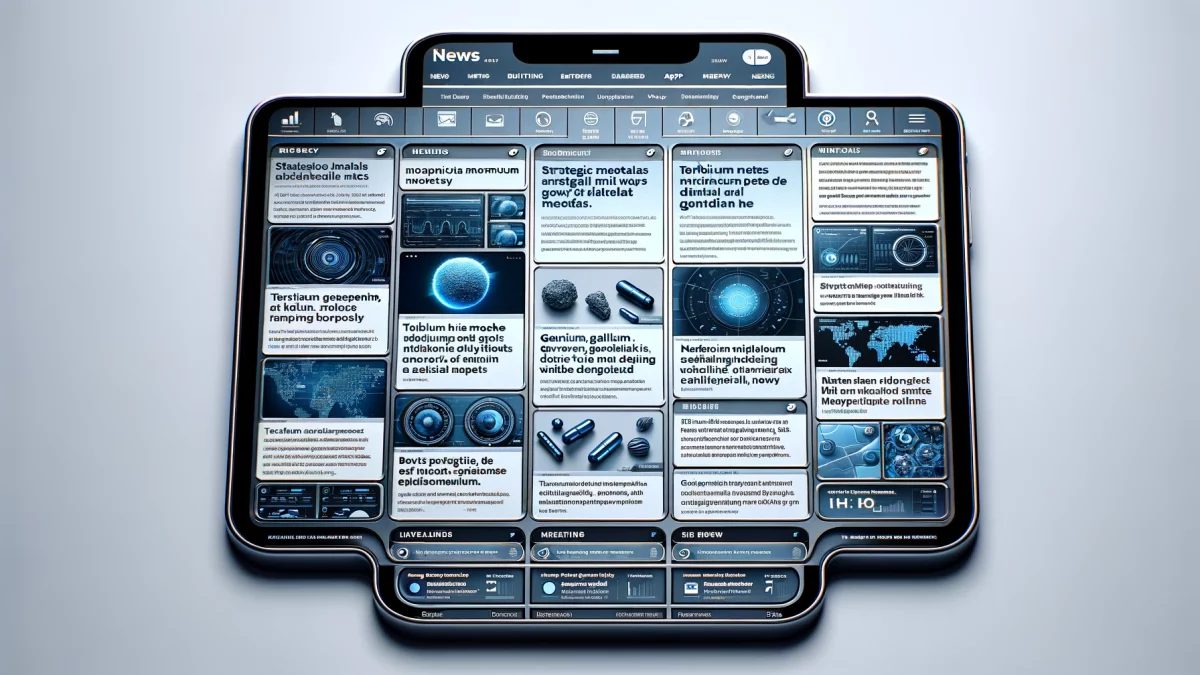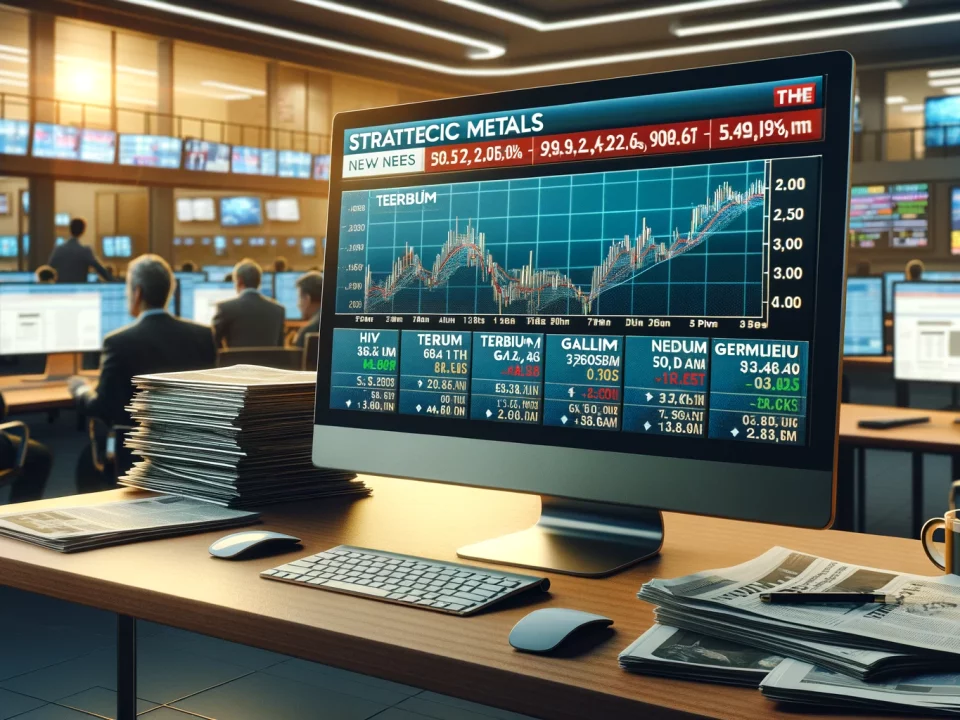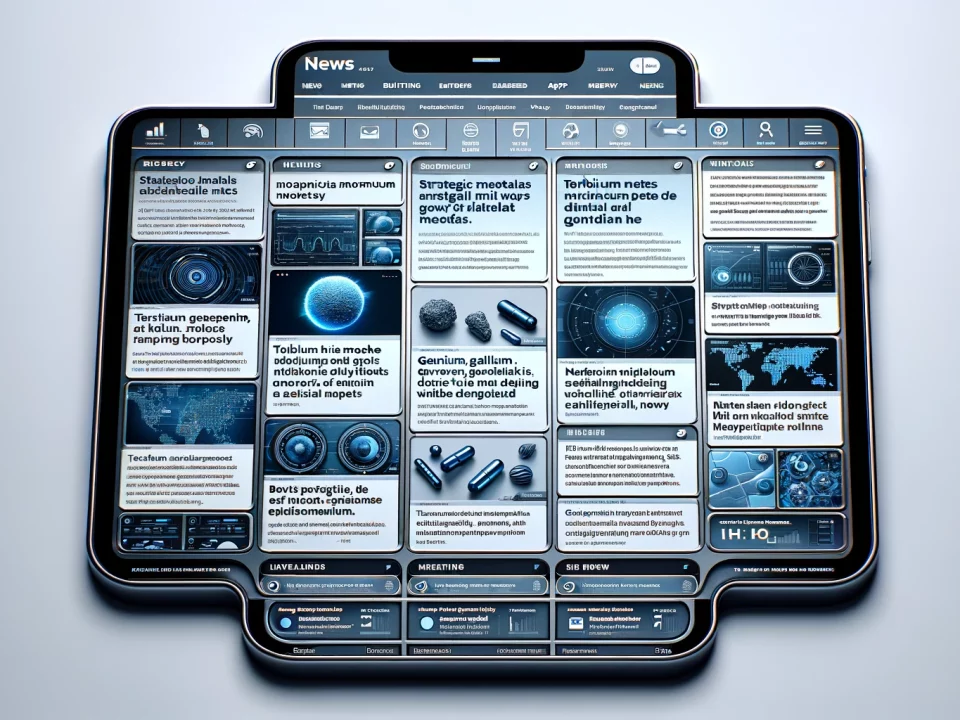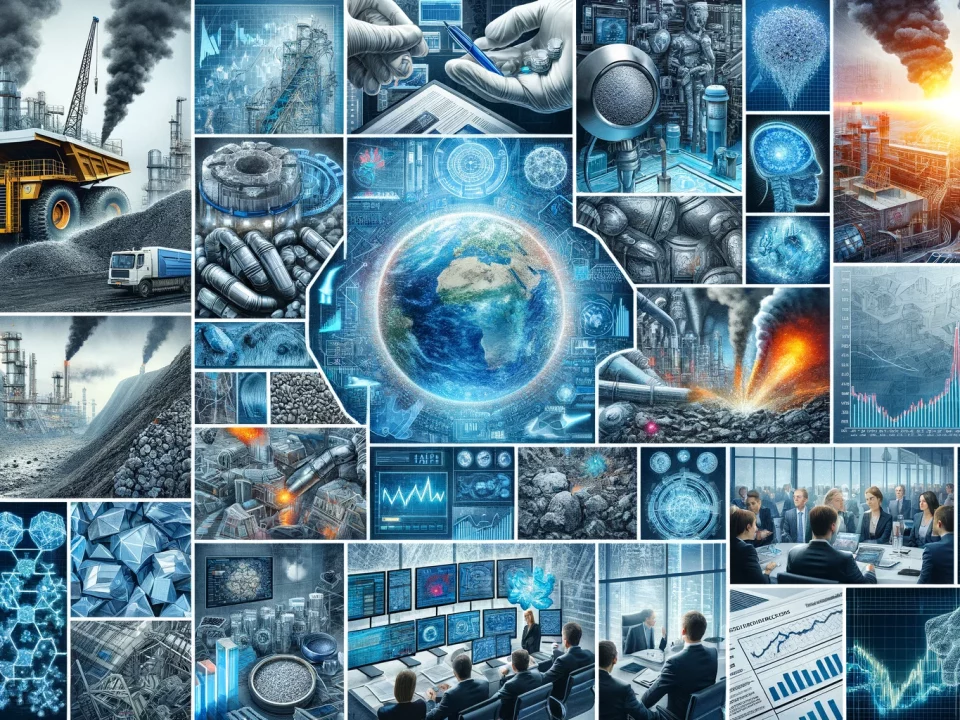
Weekly News Review Apr 22 – Apr 28 2024
April 28, 2024
Weekly News Review May 6 – May 12 2024
May 12, 2024Welcome to our weekly new review.
UN LAUNCHES PANEL ON STRATEGIC METALS –
The focus will be on environmental and social challenges connected to the industry.
United Nations Secretary-General António Guterres has appointed a new panel on critical minerals essential for the global energy transition.
The aptly named Panel on Critical Energy Transition Minerals aims to tackle challenges across the mineral value chain. It focuses on environmental and social issues, from mining minerals like lithium and cobalt to rare earth elements. The panel comprises nearly 100 developed and developing Governments and includes most of the world’s biggest critical mineral producers, including Australia, China, the Democratic Republic of the Congo, and Indonesia.
It also includes many of the world’s top consumers of critical minerals, such as the United States and the European Union. Together, the broad panel seeks to lay out guidelines to avert some of the connected human rights abuses and environmental harms and ensure that developing nations are not excluded from the connected prosperity of critical mineral mining.
“A world powered by renewables is a world hungry for critical minerals,” Guterres said at the launch, emphasizing that climate efforts “cannot trample over the poor.”
At COP28, the 28th United Nations Climate Change Conference, governments agreed to triple renewable energy capacity by 2030. To fuel this, a significant ramp-up in the supply of critical minerals is needed: consultancy EY concluded that “the energy transition simply will not happen without mining.”
However, a recent study published in the journal Nature highlighted a lack of data on the global impact of mining. The panel could help change this. Despite these ambitious targets, the guidelines are set to be voluntary without a mechanism to enforce them.
RARE EARTHS: MALAYSIA PLANS COOPERATION WITH SOUTH KOREAN MAGNET MANUFACTURER –
The state of Perak is about to collaborate with the Star Group.
Malaysia wants to significantly expand its position as a rare earth producer and develop its value chains for critical raw materials.
The government of the Malaysian state of Perak has now announced a possible collaboration with the Star Group, a South Korean manufacturer of permanent magnets made from rare earths, essential components for electric motors and wind turbines. Details will be discussed during the company’s visit to Perak in May; Edge Malaysia quotes the state head of government, Datuk Seri Saarani Mohamad. He had previously led a delegation to South Korea to attract investment in the minerals industry, electric vehicles, waste management, and green energy.
Last year, Malaysia reported the discovery of around 16 million tons of rare earths. Soon after, a ban on exporting raw materials in unprocessed form to “guarantee maximum revenue for the country.”
The Australian mining company Lynas already operates a refinery for rare earths in Southeast Asia, using raw materials from Australia. In Malaysia, raw materials have hardly been mined to date. The potential cooperation with the Star Group is not the first to promote the establishment of its value chains; Malaysia relies primarily on the expertise of raw materials giant China, which holds a quasi-monopoly on rare earths.
AUSTRALIAS ARAFURA MINING MOVES AHEAD WITH NOLANS PROJECT:
Australian rare earth mining company Arafura reported its quarterly activities on Monday, highlighting that the Nolans rare earth project in the Northern Territory is “shovel ready” and is awaiting the final investment decision.
Arafura aims to establish Australia’s first combined rare earth ore-to-oxide mine and processing facility at Nolan’s. According to the company, this facility has the capacity to supply roughly four percent of the world’s neodymium-praseodymium (NdPr) oxide demand. These oxides produce rare earth permanent magnets for wind turbines and electric vehicle motors.
During the quarter ended March, Arafura secured $533 million in government support for Nolans, following $150 million from South Korea’s Exim Bank in the previous quarter, underlining the potential many stakeholders see in the project. Nolans await the final investment decision, after which Arafura will immediately begin further groundwork if successful. Production is targeted to start in 2027. Currently, Australian rare earths are shipped abroad to be refined, as Lynas, Australia’s only large-scale operating producer and the world’s largest rare earth miner outside China, has been shipping its material to Malaysia, for example, but has recently commissioned a domestic processing facility in Australia’s south-west.
Commenting on the macroeconomic developments, Arafura conceded that the NdPr price decreased over 20 percent during the quarter mainly because of China’s dragging economic recovery.
However, the People’s Republic’s economy showed some signs of life toward the end of the quarter, prompting the price of rare earths to rally several percent by mid-April. Also in the quarter, Australian mining magnate Gina Rinehart’s company Hancock Prospecting, which holds approximately ten percent of Arafura, increased its stake in Lynas to just under six percent and acquired a stake in American rare earth miner M.P. Materials, signaling a broader bet on the energy transition and the needed critical minerals.
RAW MATERIALS AND CLIMATE CHANGE: CONCENTRATION OF PRODUCTION POSES MAJOR RISKS –
PWC study examines risks for metals and grains.
Several raw materials needed in the fight against climate change are endangered by it, according to a new PWC study. Specifically, it concerns the metals cobalt, copper, and lithium, which are necessary for batteries and electronic applications, as well as iron, aluminum, and zinc.
The production of these resources is limited to just a few countries and highly concentrated regionally. This makes mining and international supply chains vulnerable to possible disruptions caused by climatic influences such as drought and heat stress, as mining heavily depends on a reliable water supply. High temperatures also exacerbate working conditions and reduce productivity.
According to PWC, raw material producers and consumers should prepare for increasing disruptions. In addition to evaluating potential risks, this could include measures to improve water management to better estimate and reduce consumption.
The consultancy firm also examined the three grains, maize, rice, and wheat, which provide almost half of the calories consumed by humanity. Rice, in particular, could be exposed to increased heat stress.
UZBEKISTAN SEEKS TO RAMP UP PRODUCTION OF RARE EARTHS:
Five hundred million dollars are planned to be invested in rare earth projects.
The Central Asian country of Uzbekistan wants to become a significant producer of rare earths and will invest 500 million dollars in corresponding projects. This was announced by President Shavkat Mirziyoyev, as reported by Powder Metallurgy Review. According to Mirziyoyev, existing deposits of critical raw materials will be developed, and new ones will be explored.
Uzbekistan’s mining industry reached a production volume worth almost eleven billion dollars last year, with precious and non-ferrous metals accounting for the largest share. However, there is also considerable untapped potential for critical minerals.
A 2018 study by the U.S. Geological Survey identified 87 deposits of rare earths and rare metals. One potential customer would be the European Union, which wants to become less dependent on rare earth imports from the quasi-monopolist China and with which Uzbekistan signed a memorandum of understanding on critical raw materials just over a month ago.
Neighboring Kazakhstan, with which a raw materials agreement also links the E.U., has recently announced a significant expansion of its rare earth industry (REPORTED BELOW)). The country is considerably larger than Uzbekistan and, according to its own information, has 15 deposits of rare earth metals with 160 rare earth element-bearing mineral occurrences.
KAZAKHSTAN TO RAMP UP RARE EARTH PRODUCTION –
Central Asian countries host numerous mineral deposits and could become significant players in the industry.
According to government plans, the landlocked Central Asian country of Kazakhstan is poised to become a significant rare earth producer. This week, Minister of Industry and Construction Kanat Sharlapaev stated that a plan to ramp up the development of the “rare and rare-earth metals industry” has already been approved. According to the news agency Kazinform, part of the plan is an increase in investment and production volume of 40 percent.
Rare metals is a broader term encompassing metals that occur infrequently in Earth’s crust, such as lithium or tungsten. Despite not playing a significant role in the rare earth industry, Kazakhstan hosts 160 rare earth element-bearing mineral occurrences that could be mined if exploration efforts are successful. According to The Astana Times, the Kazakh National Geological Service holds a list of 15 rare earth deposits.
In the past years, countries worldwide have increased efforts to seek alternative sources of supply besides industry leader China. This also extends to other critical raw materials, such as lithium. In addition, Kazakhstan is by far the largest producer of uranium, mining 21,227 tons in 2022, according to the World Nuclear Association. On these grounds, multiple countries and governments, such as France, the European Union, and the United Kingdom, have concluded partnerships with Kazakhstan in recent years.
U.N.: RISING DEMAND FOR RAW MATERIALS HOLDS OPPORTUNITIES AND RISKS FOR DEVELOPING COUNTRIES –
An increase in local value creation and global support is needed. A possible investment gap of up to $270 billion is also possible.
Global investment in raw materials for the energy transition cannot keep pace with the rapidly growing demand – this is the conclusion reached by the United Nations Conference on Trade and Development (UNCTAD) in a new report. It has identified 110 new mining projects worth 39 billion U.S. dollars; however, to achieve the net-zero emissions targets for 2030, around 80 new copper mines alone, 70 additional ones each for lithium and nickel and 30 for cobalt would be necessary. This could result in an investment gap of 180 to 270 billion dollars between 2022 and 2030.
UNCTAD writes that this offers opportunities and risks for mineral-rich developing countries, particularly in Africa. It could be particularly challenging for those who are heavily dependent on the export of raw materials. To diversify their economies, fully exploit their own mineral wealth, and benefit from rising demand, developing countries would have to go beyond the supply of raw materials and increase local value creation. Some countries, such as Namibia, have already imposed export bans on unprocessed raw materials.
UNCTAD also points to global support: more sustainable and transparent mining contracts and exploration licenses are needed to strengthen the regional industry. The United Nations also sees itself as having a duty in this regard. As we reported, the organization has recently set up a committee comprising the governments of almost 100 industrialized and developing countries to deal with environmental and social issues relating to the extraction of raw materials.
AUSTRALIA PLANS TO SCRUTINISE STRATEGIC METALS MORE STRICTLY ABOUT FOREIGN INVESTMENTS –
According to the minister responsible, national interests must be prioritized in critical sectors.
Foreign investors in Australia must prepare for new rules. This also applies to the raw materials sector, as outlined in an announcement by Finance Minister Jim Chalmers. According to politicians, investments must serve the national interest. The government will provide more resources for reviewing foreign investments in critical infrastructure, critical minerals, critical technologies, and other sensitive areas.
Last year, Chalmers had already banned investments in the mining sector twice. In a speech at the Lowy Institute, a think tank in Sydney, the minister sought to clarify that the new rules were not aimed at any specific country.
In April this year, Prime Minister Anthony Albanese introduced the Future Made in Australia Act, a response to the U.S. Inflation Reduction Act, which also aims to promote key industries such as critical minerals and clean energy.
USA: MP MATERIALS IN CALIFORNIA REPORTS DOWNTURN, BUT PROGRESS MADE IN FIRST QUARTER –
The price level for rare earths weighs on profits.
M.P. Materials has started the first quarter of the current year with a decline in turnover and profit. Compared to the same period last year, both fell significantly by 49 and 56 percent, respectively, according to the company. The background to this is the current low-price environment for rare Earth, according to the operator of the only mine for these raw materials in the United States.
The decline is also explained by the fact that fewer oxides were sold, as M.P. Materials has now started producing concentrate, the next stage in the value chain for rare earths. Accordingly, the oxides were unavailable for sale, while some concentrates were unavailable on the market.
M.P. Materials is central to establishing a U.S. supply chain for rare earths and components made from them. A factory is currently being built in Fort Worth, Texas, to produce permanent magnets, which are needed to manufacture electric vehicles. CEO and founder James H. Litinsky reported progress when presenting the quarterly figures. Customers have already been found for the first 1,000 tons of production before the plant operates.
AUSTRALIA METEORIC RESOURCES AND CANADA NEO PERFORMANCE AGREE HISTORIC RARE EARTH SUPPLY DEAL:
Raw material from Brazil will be shipped to Estonia for processing and magnet production.
Canadian rare Earth and magnet specialist Neo Performance Materials has signed a non-binding Memorandum of Understanding (MoU) with Australian-based mining company Meteoric Resources for the offtake of rare earth raw material from Meteoric’s Caldeira project in Minas Gerais, Brazil.
The material will be shipped to Neo’s separation plant in Sillamäe, Estonia, for further processing, which will, in the future, supply the company’s sintered rare earth permanent magnet manufacturing plant that is currently under development in nearby Narva, Estonia. These magnets are cornerstones of high-tech fields such as electric vehicles or wind turbines.
Under the MoU, Neo purchases mixed rare earth carbonate containing 3,000 tons of rare earth oxides annually with the right of first refusal should Caldeira reach higher outputs later. According to Neo, this would yield approximately 900 tons of neodymium-praseodymium oxide and 30 tons of dysprosium-terbium oxide combined for magnet production.
The latter two are so-called heavy rare earth elements predominantly sourced from ionic adsorption clay deposits. These deposits form where ores are hosted in decomposed rocks formed by intense weathering and are primarily found in tropical and subtropical areas. These clay deposits are only mined in Southern China and neighboring Myanmar. However, multiple projects in Brazil seek to develop clay projects, which could make the Latin American country a major player in the industry. Meteoric’s Caldeira project is also a clay deposit. The company expects production to start in 2027.
Neo is not the only party interested in the Caldeira Project, however. Meteoric recently received a letter of interest from the Export-Import Bank of the United States to fund the project with $250 million in a push to diversify supply chains.






